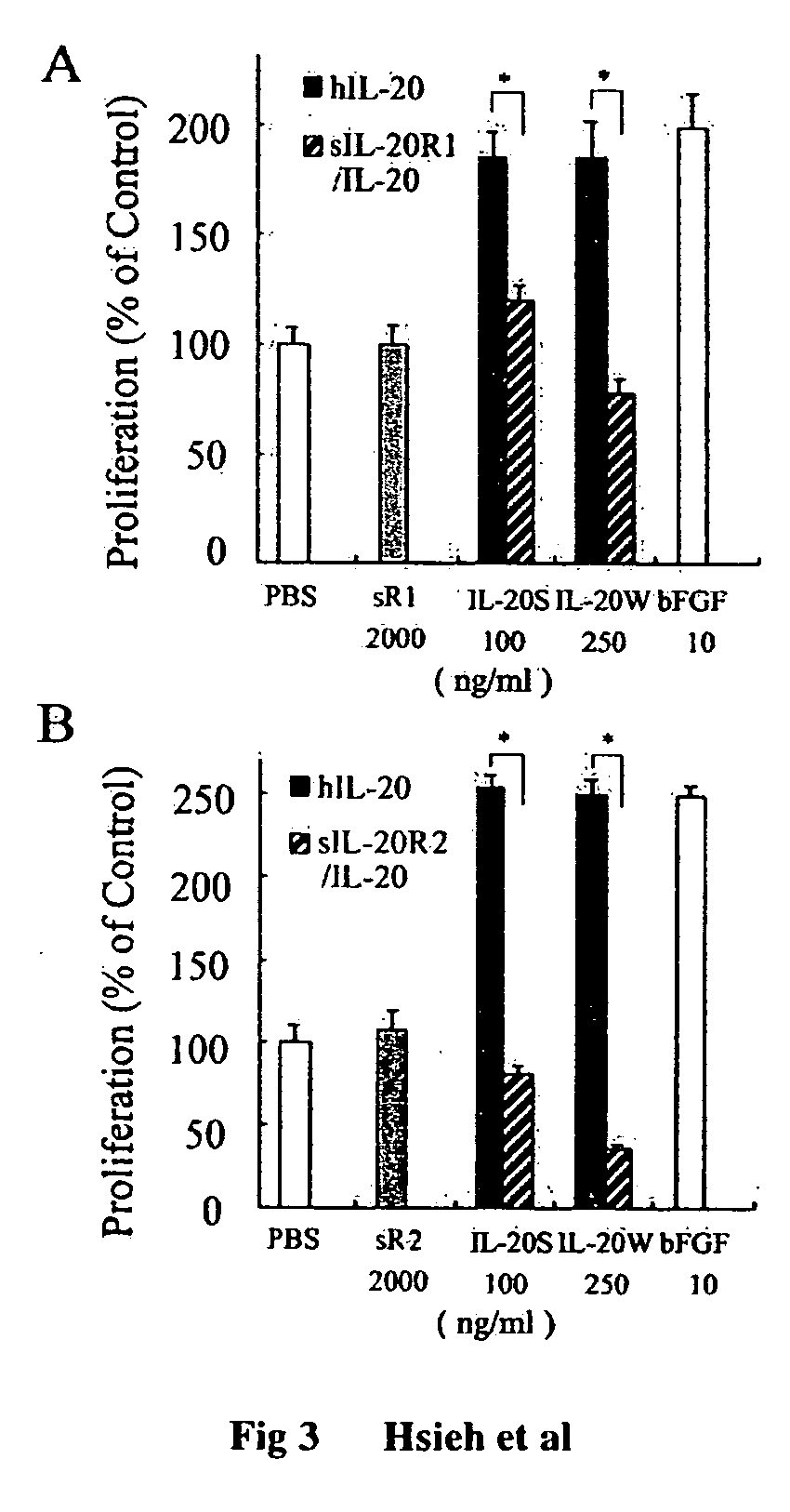[0050] IL-10 can inhibit the generation of new vessels within a tumor both directly on tumor cells and indirectly by influencing infiltrating immune cells. IL-10 reduced the secretion of MMP-2 and MMP-9 from prostate cancer cells. Consequently, microvessel formation was inhibited. IL-10 downregulates MMP-2 to block tumor growth, angiogenesis, and metastasis, and TGF-P1 upregulates MMP-2 to stimulate tumor growth, angiogenesis, and metastasis. Because IL-10 downregulates several factors associated with angiogenesis, and IL-20 increases the proliferation of endothelial cells, we speculate that IL-20 may upregulate angiogenesis factors. Therefore, we treated CPAEs with hIL-20 and analyzed the transcripts of several angiogenesis factors: bFGF, TGF-β1, VEGF, MMP-2, and MMP-9. Bovine HPRT transcript was used as an internal control. Human IL20 upregulated the transcriptional levels of bFGF, VEGF, TGF-β1, and MMP-9 (FIG. 5; Table 2). TABLE 2Induction of bFGF, VEGF, TGF-PI, MMP-2, and MMP-9 transcripts oncalf pulmonary artery endothelial cells (CPAEs) by human (h)IL-20BFGFVEGFTGF-b1MMP-2MMP-9Untreated−−++−hIL-20W++++−hIL-20S++++++++
[0051] To confirm the expression of IL-20 receptors on endothelial cells, immunostaining of both IL-20R1 and IL-20R2 was performed on CPAEs using antibody against hIL-20R1 and hIL-20R2 subunits. Strong immunoreactivity was detected for IL-20R1 in CPAEs, whereas moderate immunoreactivity was detected for hIL-20R2 (FIG. 6A). HaCaT cells, the positive control, exhibited moderate immunoreactivity toward both hIL-20R1 and hIL-20R2. This result indicated that human and bovine IL-20 receptors may share significant homology and that hIL-20 acted across species on bovine cells. These results demonstrated that endothelial cells expressed functional receptor subunits for IL-20.
[0052] Proliferation of endothelial cells plays a crucial role in atherosclerosis. IL-20 induced proliferation of endothelial cells. Furthermore, chronic inflammation plays a pivotal role in the progression of atherosclerosis. IL-10 exerts important protective effects against the development of atherosclerosis lesions in experimental animals. Therefore, we wanted to see whether IL-20 also played some role in atherosclerosis. ApoE-knockout mice demonstrate the atherosclerosis phenotype. Thus, we used antibodies against IL-20 or its receptors in immunostaining to analyze the expression of the ligand or the receptors in the atherosclerosis lesion in 24-week-old ApoE− / − atherosclerotic mice. We found that IL-20 was upregulated in the atherosclerosis plaque of ApoE-deficient mice (FIG. 6Bi-j). To examine whether the expression of IL-20 receptors is also altered in atherosclerosis lesions, immunostaining of IL-20RI and IL-20R2 was performed in cryosections of the aortic arches of ApoE− / − mice and normal C57BL / 6 mice. In the aortic arches of normal C57BL / 6 mice, low levels of IL-20R1 and IL-20R2 were detected in a portion of the endothelial cells (FIG. 6Bb,f). In contrast, strong immunoreactivity was detected for both IL-20R1 (FIG. 6Ba) and IL-20R2 (FIG. 6Be) in the endothelium of the aortic arches of ApoE− / − mice. In addition, intensive staining of IL-20R1 and IL-20R2 was detected in atherosclerosis plaque. Immunoreactivity was detected in the adventitia of the aortic arches of both C57BL / 6 and ApoE− / − mice. These results indicated that both IL-20 and IL-20 receptors are induced in atherosclerosis plaque and are markedly upregulated in the endothelium of atherosclerotic aortas.
[0053] Rheumatoid arthritis (RA) is a common chronic inflammatory polyarthritis of worldwide distribution, with a female predomaince of 3:1 and a peak onset in the fourth decade of life. Intense inflammation occurs in synovial joints, so that the normally delicate synovail “membrane” becomes infiltrated with mononclear phagocytes, lyphocytes, and neutrophils. An inflammatory fluid is usually exuded by the inflamed synovium. In addition to pain and loss of mobility of joints patients frequently develop systemic manifestation, such as anemia, subcutaneous of manifestation nodules, pleurisy, pericarditis, interstitial lung disease, and manifestation of vasculitis such as nerve infarction, skin lesion, and inflammation of the ocular sclera. The course of RA is variable, but usually patients undergo progressive loss of cartilage and bone around joints with resulting diminished mobility.
[0054] Although the course of RA remains unknown, a number of its features are suggestive of an autoimmune etiology. The pathology of arthritic joints suggests a T-cell-mediated chronic inflammatory reaction. Most patients (over 80%) develop antibody in their blood called IgM rheumatoid factor RF, mostly produced in the marrow, but with significant production by the inflamed synovium. The presence of intrasynovial immune complex, together with diminished levels of complement components, implies an involvement of RF in some of the local pathology. In recent years, however, much interest has focused on the T cell and mononuclear phagocytes infiltrating the joint. T cells are probably polyclonal, although evidence for selective expansion of certain Vβ subsets exists and has led some investigators to propose a role for superantigens. Depletion of T cells by thoracic duct drainage, or by immunosuppressive drugs such as cyclosporine, has resulted in improvement, implying an important role for T cells in the inflammatory process. Much work on intrasynovial cytokines, however, has pointed toward mononuclear phagocytes as the prime driving force of the inflammatory process.
[0055] The synovial fluid in RA contains primarily cytokines of mononuclear origin, including IL-1, IL-6 and TNF-α. IL-1 receptor antagonist can also be demonstrated in most fluids. In contrast, IL-2, IFN-v, and other T-cell cytokines are usually present in only small quantities, with the possible exception of IL-17. Efforts to treat RA with T-cell-depleting monoclonal antibodies have yielded disappointing results. In contrast, administration of monoclonal antibodies to TNF-α has resulted in marked reduction of inflammation. Modest improvement has also been reported for antibodies to IL-6 and with administration of IL-1 receptor antagonist.
 Login to View More
Login to View More 


